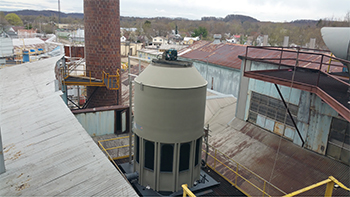Cooling Towers Play Role in Industrial Water Conservation Efforts
 Evaporative cooling towers, which can use millions of gallons of water per year, have provided the most cost effective cooling technology for industrial processes. However, with severe droughts throughout the United States, the issue of reducing water usage is now at the forefront.
Evaporative cooling towers, which can use millions of gallons of water per year, have provided the most cost effective cooling technology for industrial processes. However, with severe droughts throughout the United States, the issue of reducing water usage is now at the forefront.
The current techniques used to reduce water requirements involve alkaline, high pH water treatment chemistries that destroy galvanized metal cooling towers. To conserve water, facility engineers are faced with the prospect of having to replace the cooling towers every 5-8 years.
This is opening the door for more applications for engineered plastic cooling towers. The engineered HDPE (high-density polyethylene) plastic involved is impervious to very high and low pH water as well as other chemicals. These units can withstand decades of service in the harshest industrial or environmental conditions.
Cooling Tower Water Usage
In each facility, water loss is expected due to the nature of the evaporative process that cools the air. Drift, water in the form of fine mist lost into the atmosphere, is also considered unavoidable. For the system to remain at full efficiency, the water loss must be replaced on an ongoing basis.
Avoidable water loss is another matter.
The hard water used in cooling towers contains scale-forming minerals, such as calcium and magnesium salts, but in the evaporative process these solids are left behind in high concentrations.
Left undiluted, these minerals cause scaling on equipment. A small amount of scale in the system results in lower efficiency of heat transfer and a decrease in productivity in industrial processes. In severe cases, scale can completely plug the piping.
To protect against scale build-up, some of the water is removed and replaced with fresh water. The water drained from the equipment is called “blowdown” or “bleed” water.
This amount of water loss can potentially be prevented or, at minimum, greatly reduced. Water conservation efforts primarily focus on achieving “zero blowdown” to reduce the amount of fresh water required.
Achieving Zero Blowdown
The primary method of reducing Blowdown involves using chemical additives to impede scaling. These chemicals extend the solubility of the miners so high concentrations can exist without causing scale or corrosion.
More advanced techniques include using “soft” water, with no calcium or magnesium salts, through the cooling tower. Soft water chemistries are available from companies such as Arizona-based, ProChemTech, which provides technology to substantially reduce blowdown or achieve zero blowdown.
Engineered Plastic Towers
More options are becoming available for the protection of the cooling tower systems that are able to avoid any white rust corrosion issues.
In the new system, the plastic cooling tower discharges cold water into a cold well inside the plant. Cool water is then pumped through a stainless steel plate and frame heat exchanger before it is returned to the tower. Furnace cooling water is then re-circulated by a closed loop system, which is cooled by the heat exchanger, retaining the closed loop design provided by the fluid cooler.
These new plastic cooling towers also have inherent and design advantages, which allow for easier installation, particularly on rooftops because a lightweight plastic shell weighs as much as 40 percent less than a steal tower, according to Timothy Keister, chief chemist and president of ProChemTech.
Systematic Issues Impede Water Conservation Efforts
Although these new engineered plastic cooling towers are an effective solution to water conservation, it does not come without its difficulties. While the cooling towers would provide a solution, they can be more expensive than other water treatment practices. Many will choose to go with the cheapest bid instead of the one that will conserve water in the future due to upfront costs of the system.
Jeff Elliott is a Torrance, Calif.-based technical writer. He has researched and written about industrial technologies and issues for the past 20 years.
